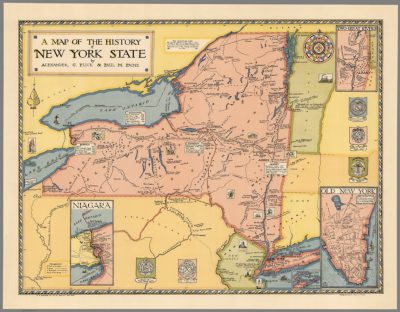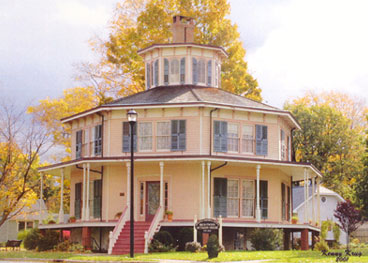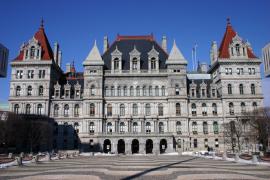
The time has come to create the New York Association for State and Local History (NYASLH). There is a void, an absence of leadership in the state history community. There is no one to speak on behalf of the community at the statewide level. Many people work quite hard and often for no money on behalf of a beloved local historical organization, to remember a person, to commemorate an event. These people are the unsung heroes of the state history community but their dedication, their devotion, and their commitment are not enough. There is a need for leadership at the state level and none exists.
The name for the proposed organization is a direct borrowing from an existing national organization. This borrowing should not be construed as suggesting that American Association for State and Local History is officially connected to this effort or is working to build support for creating an NYASLH.
The American Association for State and Local History (AASLH) is a national association that provides leadership and support for its members who preserve and interpret state and local history in order to make the past more meaningful to all people.
In 1904, the American Historical Association, itself a fledgling professional body, established the semi-autonomous Conference of State and Local Historical Societies to serve the leaders of those agencies. In 1939, a group of Conference members discussed and then proposed the creation of an independent entity. Its job would be to better coordinate the activities of historical societies and stimulate the writing and teaching of state and local history in North America.
On December 27, 1940, the Conference of State and Local History met and disbanded itself. Then the American Association for State and Local History was born. Its first charter stated that AASLH’s purpose was, simply, “the promotion of effort and activity in the fields of state, provincial, and local history in the United States and Canada.”
Now, the AASLH is providing services and assistance to over 5,500 institutional and individual members, as well as leadership for history and history organizations nationally. It is the only comprehensive national organization dedicated to state and local history.
The functions of the organization are fourfold.
1. Advocacy – AASLH knows it is important for all public officials (local, state, and national) to know about the vital work historical organizations do to educate the general public—the constituents of public officials—about your work and its role in a democratic and civil society, making citizens more thoughtful about the decisions they make and the consequences of those decisions. Advocacy and lobbying are also important leadership services provided by AASLH. AASLH sponsors, advocates, and lobbies on behalf of state and local history at the national level through strategic partnerships with several organizations.
2. Leadership: We create and run high quality continuing education programs for individuals and organizations, including the first-ever national standards program for small and medium history organizations (StEPs).
3. Community: We facilitate networking and discussion both in person at our Annual Meeting and on-site workshops as well as online through our website, Online Conference, and Affinity Groups.
The organization does not have local or state chapters so there is an opportunity for New York to be the first. We don’t need to reinvent the wheel. We need to make the existing one work for us. NYSHA could have done this job but it didn’t.
In a previous blog, I posted an email I had received from Terry Abrams, the Administrative Coordinator for the Western New York Association of Historical Agencies (WNYAHA), on the subject of the Yorkers and his own experiences with it.
In a second email, Terry described his experiences as an adult and his observations about what New York is not doing compared to other states.
As a member of the Field Services Alliance (FSA), an affinity group of AASLH, I have had the opportunity to work with others doing the same type of work I do. One of the significant differences between NY and other states, is the absence of a local history program in a state historical society.
There is a simple explanation for the absence of a local history program in a state historical society – THERE IS NO STATE HISTORICAL SOCIETY. There is the Connecticut Historical Society. There is the Massachusetts Historical Society. And yes there is The Rhode Island Historical Society. There is a New York State government museum in Albany. There is the New-York Historical Society in New York City. And there was a New York State Historical Association in Cooperstown with two museums. But the sad reality is that there is no history organization in New York State functioning in a leadership role.
Terry then noted his experiences with state organizations elsewhere.
If you look at Minnesota’s Historical Society, the Ohio History Connection, and the Indiana Historical Society among others, you can see that all of these states, which geographically, are smaller or equivalent to NY, and population-wise are smaller; all are much more active in promoting and serving local history.
Just one example, the Indiana Historical Society’s Local History Services department has four full-time people for a state that is just over 36,000 square miles, (ranked 38th), and has a population of a little over 6 million (ranked 17th). Compare that with NY, with just over 54,000 square miles (ranked 27th) and a population just under 20 million (ranked 4th). [information gathered from Wikipedia, for what it’s worth.]
Indiana Historical Society’s Local History Services department is larger than MANY, WNYAHA and GHHN combined. Keep in mind, also that MANY’s mission is to serve all museums, not just historical agencies.
I had the opportunity to host the spring training meeting of the FSA this year [2017] at the Theodore Roosevelt Inaugural Historic Site. 17 members from across the country came and shared information about what we are doing, and discussed important developments in our field. Erika Sanger came and spoke about the Museum Education Act, and the work MANY has been doing providing information about Common Core to museum educators, and others. We also had a presentation from Dr. Patrick Ravines, director of the Buffalo State Art Conservation Program.
To get a better sense of what Field Service professionals do, click on “core documents.” You can go through and find almost all you need to know about field services. (The information on the listing of field service providers is slightly out of date). I believe this is what is primarily lacking in the history community of NY.
In this example, Terry points out the obvious fact that New York is one of fifty states. Therefore it becomes possible to benchmark the performance here against other states. It would be good to attend a best practices session or some other session at a national conference devoted to what the states are doing. While New York loves to brag about being the only state to require municipal historians, an unenforced and unfunded law, it is forced to hang its head in shame for the void in leadership of the state history community, especially compared to what used to exist.
An editorial in the Lake George Mirror highlights what once was.
Lake George residents have a special interest in the former Association, in part because it was founded on Lake George in 1899, met annually at the Fort William Henry Hotel and counted residents like John Boulton Simpson among its first trustees. It also had its first permanent headquarters in Ticonderoga’s Hancock House, built specifically for that purpose by Horace A. Moses in 1926.
Of greater importance, without the New York State Historical Association, there would be little of Fort George or the Lake George Battlefield left today. New York State had begun to acquire the parcels that comprise the parks in the 1890s, but had little idea of what could or should be done with them.
The Historical Association stepped in and assumed responsibility for maintaining the sites.
Under the association’s auspices, the stone bastion was rebuilt and the bronze statues honoring Sir William Johnson and King Hendrick, Isaac Jogues and the Native Americans were installed.
The association assumed responsibility not only for protecting the sites but promoting them, as a 1930 editorial in the Lake George Mirror acknowledged. “An officer of the New York State Historical Association told the Mirror editor a few days ago that something could be done at Fort George Park if the people of this section would only ask for it,” editor Art Knight wrote.
By “something,” the officer and Knight meant a reconstructed fort and a museum to house artifacts similar to that of Fort Ticonderoga’s, which was already attracting 80,000 visitors a year.
The plight of New York state history has been a constant source of anguish. Bruce Dearstyne, formerly of the Office of State Historian, in a post for New York History Blog, wrote about the history of NYSHA and identified its five goals:
1. To promote and encourage original historical research.
2. To disseminate a greater knowledge of the early history of the State by means of lectures, and the publication and distribution of literature on historical subjects.
3. To gather books, manuscripts, pictures and relics relating to the early history of the State, and to establish a museum at Caldwell, Lake George, for their preservation.
4. To suitably mark places of historical interest.
5. To acquire by purchase, gift, device, or otherwise, the title to, or custody and control of, historic spots and places.
He also mentioned one key ingredient to making the organization work – money.
Benefactors are highly desirable and important. Horace Moses, a wealthy owner of paper mills, provided NYSHA’s first headquarters in Ticonderoga. The Clark family, beginning with Steven Clark and continuing to his granddaughter Jane Forbes Clark, provided substantial resources for NYSHA. But this also means that the organization needs to be attuned to their interests and priorities.
Perhaps instead of in Cooperstown, the proposed NYASLH should be headquartered where the action is. The New-York Historical Society is over two centuries old and began as museum of the world (including possessing Egyptian artifacts and I don’t mean from Cairo, New York). The New-York Historical Society also houses the collection of the Gilder Lehrman Institute. And even though Lewis Lehrman was a candidate for governor of New York, the Gilder Lehrman Institute has no particular interest New York State history. Its purview is American history. Manhattan is the center of the universe so its taking a leadership role in the state is not going to happen.
Our capital, of course, is not in New York City. There are many groups located in Albany or nearby advocating on behalf of a state wide constituency. I expect to attend two such advocacy days in March. There is none for history. Perhaps the Albany Institute of History and Art founded in 1791 could fill this void or agree to house a new non-profit organization dedicated to advocating for New York State history. Maybe somewhere else could. Does anyone have any ideas? Does anyone have any money?








